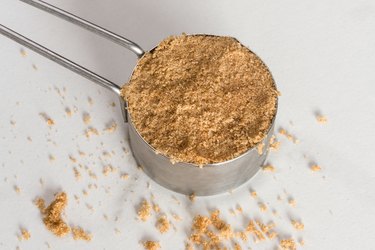
Ever wonder where that sweet brown sugar that's so popular for baking originated? Brown sugar has a long history as the earliest recorded sugar. Brown sugar comes in several different types, and it's made a few different ways, but it's essentially white sugar with a molasses-like flavor.
Basics of Brown Sugar
Video of the Day
Brown sugar comes from sugar cane or sugar beets. They're cut and squeezed for their juice, which is boiled until it thickens to molasses. Sugar crystals settle out of this mixture, and are stripped of the molasses through centrifuging and drying.
Video of the Day
White sugar is the result of this process. But stopping a little early is one way to produce brown sugar. It comes from leaving some of the molasses on the sugar crystals.
Ancient Times
Sugar cane cultivation originated in southwest Asia, where Marco Polo reported in his famous journals that the Chinese used dark brown sugar freely without additional refining. Sugar cultivation spread to the Middle East and the Mediterranean trade circle in the twelfth and thirteenth centuries.
In the fourteenth century, the island of Cyprus was the location of major sugar farms, using Syrian and Arab slaves as labor. Sugar cane cultivation was made a science in the fifteenth century in Sicily, with the invention of the roller mill to speed up the process. In those times, brown sugar was a byproduct of sugar refining, and wasn't used widely in cooking until the sixteenth century.
1700s Sugar Trade
Brown sugar came into popular use with the rise of European sugar plantations in the Caribbean in the 1700s. It was widely used as a sweetener in England and its American colonies, because it was much cheaper than white sugar. The use and export of brown sugar from the islands rose in conjunction with the infamous "triangle trade."
The Triangle trade was a three-legged trade route. Manufactured goods went from Europe to Africa, where people were enslaved and taken to the Caribbean islands and sold as slaves. The third leg moved slave-produced goods like sugar, tea, cotton, tobacco and coffee to the colonies and Europe.
Geography of Brown Sugar
In the 1400s, sugar cane boomed on Portuguese and Spanish Atlantic Ocean islands. Sugar plantations that produced brown and white sugar grew up in the "West Indies," as they were called at the time, or Caribbean islands, in the 1700s. Cuba, Jamaica and Barbados were top locations for sugar plantations.
Santo Domingo and Puerto Rico were among the earliest sugar islands, in the early sixteenth century. Brazil had many sugar-producing plantations, as early as the late 1500s, and continues lead sugar production. In modern times, Hawaii, Australia, Europe, Thailand and South Africa are major sugar producers.
Uses of Brown Sugar
Brown sugar uses historically included sweetening drinks, baking breads and pastries, and making candies and sauces. It's used now to add molasses flavor to baked goods and other recipes. Light brown sugar usually works as a substitute for white sugar.
It's also a popular ingredient in body scrubs. The granulated texture exfoliates dead skin cells and dirt from the skin. Plus, it smells nice.
Types of Brown Sugar
Light and dark are two popular types of brown sugar in baking. Dark brown sugar has a darker color and stronger molasses flavor. It's used in gingerbread, mincemeat, baked beans and other heavier-flavored foods. Light brown sugar is often used in baking and making glazes, condiments and candies.
Turbinado sugar, which is partially unprocessed sugar with large, light brown crystals, is often used in tea or coffee. Muscovado, or Barbados sugar, is very dark brown, strongly flavored, and has larger crystals and a stickier texture than regular brown sugar. Demerara sugar is another specialty sugar with large, light brown crystals and a sticky texture.
Brown Sugar Benefits
Some people think brown sugar benefits include more vitamins, calcium and iron than refined white sugar because it's not as processed. But brown sugar still has the same calories and negative effects that white sugar does on teeth, blood sugar and weight. Whether brown sugar has any health benefits is a theory that remains unproven.